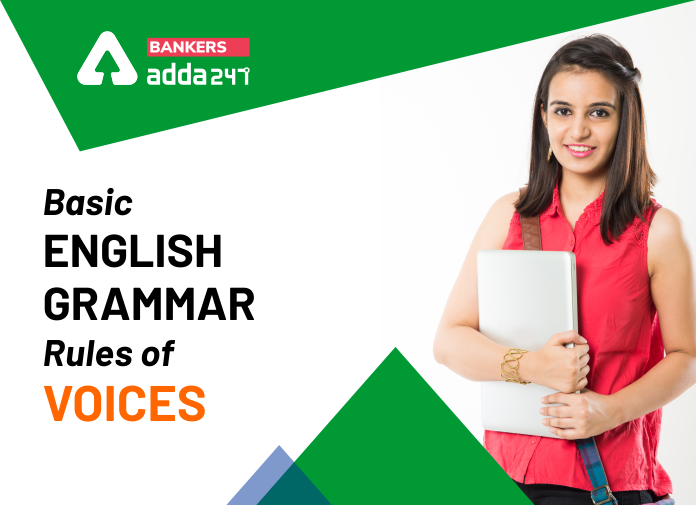English Language section is very important from exam point of view and if you are a banking aspirants then you must be knowing the importance of English Language section. It can easily fetch you some very good marks if you will attempt it carefully and with accuracy. Especially Grammar is very important section and students often get confused in this because of the formulas but with practice you can ace them all. In this article, we will be covering one of the most important topic of English grammar that is Voices
Also read,
- Basics Rules of Noun
- Basic Rules of Verb
- Basic Rules of Subject-Verb Agreement
- Basic Rules of Conditionals
What is Voices?
Voices is that form of the verb which is used to define the relationship between action and the participants of actions (subject, object). When the subject is the sentence is an agent or doer of the action, the verb is in the active voice but when the subject is being acted upon, the verb is said to be in the passive voice.
Example: Sita Takes Tea ( Active form because subject is doing something)
Tea is taken by sita (Passive form)
Rules For Changing The Verbs:
- Subject is place of a Object and object is placed in place of subject.
- “By” +Noun/Pronoun for showing doer or agent of some work
- We can change voice of only a transitive verb, i.e., a verb with an object. We cannot change the voice of an Intransitive verb.
| TENSE | VERB IN ACTIVE VOICE | VERB IN PASSIVE VOICE |
| Present Indefinite | V1 | Is/are/am + V3 |
| Past Indefinite | V2 | Was/Were + V3 |
| Future Indefinite | Shall /Will + V1 | Shall/Will + be + V3 |
| Present Continuous | Is/are/am + V + ing | Is/are/am + being + V3 |
| Past Continuous | Was/Were + V + ing | Was/Were + being + V3 |
| Present Perfect | Has/Have + V3 | Has/Have + been + V3 |
| Past Perfect | Had + V3 | Had + been + V3 |
| Future Perfect | Shall/Will + have + V3 | Shall/Will + have + been + V3 |
Also read,
- How to Increase Calculation Speed to Crack Bank Exams?
- English Grammar Rules that Can Get You Confused
Change Of Active Voice Into Passive Voice
Active and Passive Voice Rules for Present Simple Tense
Given below is the table, Rules of Active and Passive Voice with examples for Present Simple.
|
Active Voice |
Passive Voice (Auxiliary Verb – is/am/are) |
|
Subject + V1+s/es+ object |
Object+ is/am/are+ V3+ by + subject |
|
Subject + Do/does+ not + V1 + Object |
Object + is/am/are+ not + V3+ by Subject |
|
Does+ Subject+ V1+Object+? |
Is/am/are + Object+ V3+ by subject +? |
Examples-
Active: She reads a novel.
Passive: A novel is read by her.
Active: She does not cook food.
Passive: Food is not cooked by her.
Active and Passive Voice Rules for Present Continuous Tense
Given below is the table with Rules of Active and Passive Voice with examples for Present Continuous tense.
|
Active Voice |
Passive Voice (Auxiliary Verb- is/am/are + being) |
|
Subject + is/am/are+ v1+ ing + object |
Object+ is/am/are+ being+ V3+ by + subject |
|
Subject + is/am/are+ not+ v1+ ing+ object |
Object + is/am/are+ not + being+V3+ by Subject |
|
Is/am/are+ subject+v1+ing + object+? |
Is/am/are + Object+ V3+ by subject +? |
Examples:
Active: Riya is singing a song.
Passive: A song is being sung by Riya.
Active: Ketak is not chopping vegetables.
Passive: Vegetables are not being chopped by Ketak
Also Read,
| Upcoming Bank Exams 2020 | Government Jobs for Graduates 2020 | Consumer Price Index: Definition, Types, Measurement |
Active and Passive Voice Rules for Present Perfect Tense
Given below is the table with Rules of passive voice for present perfect tense from the list which are given below.
|
Active Voice |
Passive Voice (Auxiliary Verb- has/have +been) |
|
Subject + has/have+ v3+ object |
Object+ has/have+ been+ V3+ by + subject |
|
Subject + has/have+ not+ v3+ object |
Object + has/have+ not + been+V3+ by Subject |
|
Has/have+ subject+ v3 + object+? |
Has/Have + Object+ been+V3+ by subject +? |
Example-
Active: Nita has challenged her.
Passive: She has been challenged by Nita.
Active: Radha has not written an article.
Passive: An article has not been written by Radha.
Active and Passive Voice Rules for Past Simple Tense
Given below is the table with rules of Active and Passive Voice Rules for past simple tense.
| Active Voice | Passive Voice
(Auxiliary Verb- was/were) |
| Subject + V2+ object | Object+ was/were V3+ by + subject |
| Subject +did+ not+v1+ object | Object + was/were+ not +V3+ by Subject |
| Did+ subject+V1+ object+? | Was/were + Object+ V3+ by subject +? |
Examples-
Active: Reena cleaned the floor.
Passive: The floor was cleaned by Reena.
Active: Aasha bought a bicycle.
Passive: A bicycle was bought by Aasha.
Also Read,
Active and Passive Voice Rules for Past Continuous Tense
Given below is the table with rules of Active to Passive Voice according to given rules below.
| Active Voice | Passive Voice
(Auxiliary Verb- was/were + being) |
| Subject + was/were + v1+ing+ object. | Object+ was/were +being+V3+ by + subject |
| Subject +was/were+ not+v1+ing + object | Object + was/were+ not +being+V3+ by Subject |
| Was/were+ Subject + V1+ing + object+? | Was/were + Object+ being+v3+ by+ subject+? |
Examples-
Active: Nikki was painting the wall.
Passive: The wall was being painted by Nikki.
Active: Manish was repairing the truck.
Passive: The truck was being repaired by Manish.
Active and Passive Voice Rules for Past Perfect Tense
Given below is the table with rules of Active and Passive Voice Rules for Past perfect tense, with these only you can convert any sentence in Passive Voice.
| Active Voice | Passive Voice
(Auxiliary Verb- had +been) |
| Subject + had + v3+ object. | Object+ had+been +V3+ by + subject |
| Subject +had+ not+v3+ object | Object + had+ not +been+V3+ by Subject |
| Had+ Subject + V3+ object+? | Had + Object+ been+v3+ by+ subject+? |
Examples-
Active: Manisha had cleaned the floor.
Passive: The floor had been cleaned by Manisha.
Active: Nidhi had not received the parcel.
Passive: The parcel had not been received by Nidhi.
Also Read,
- How to Increase Calculation Speed to Crack Bank Exams?
- English Grammar Rules that Can Get You Confused
Active and Passive Voice Rules for Future Simple Tense
Given below is the table with rules of Active Voice and Passive Voice Rules chart for future simple tense.
| Active Voice | Passive Voice
(Auxiliary Verb- will+ be) |
| Subject + will+ v1+ object. | Object+ will+ be +V3+ by + subject |
| Subject +will + not+ V1+object | Object + will+ not +be+V3+ by Subject |
| Will+ Subject + V1+ object+? | Will + Object+ be +v3+ by+ subject+? |
Examples-
Active: Kaaya will sew the bag.
Passive: The bag will be sewed by Kaaya.
Active: Nisha will not arrange the things.
Passive: The things will not be arranged by Nisha.
Active and Passive Voice Rules for Future Perfect Tense
Giveb below is the table with rules of Active Voice and Passive Voice Rules chart for future perfect tense.
| Active Voice | Passive Voice |
| Subject + will+ have +v3+ object. | Object+ will+ have+ been +V3+ by + subject |
| Subject + will+ have +not+v3+ object. | Object + will+ have +not+been+v3+ subject |
| Will+ Subject+have+v3+ object+? | Will + object+have+been+v3+by +subject+? |
Examples-
Active: They will have brought the books.
Passive: The books will have been brought by them.
Active: Namish will not have changed the table cover.
Passive: The table cover will not have been changed by Namish.
There are no rules related to Passive Voice formation for these tenses-
1.) Present Perfect Continuous Tense
2.) Past Perfect Continuous Tense
3.) Future Perfect Continuous Tense
4.) Future Continuous Tense
Also Read,
What is imperative
An Imperative sentence is the sentence which expresses an order, request, command etc. An imperative sentence takes the following forms in passive voice.
(i) Let + Noun + be + V3
For Ex – Shut the door. (Active)
Let the door be shut. (Passive)
(ii) You are requested/ordered/advised etc to + V1 + Obj.
For Ex – Please bring a glass of water. (Active)
You are requested to bring a glass of water. (Passive)
(iii)Sub + should + be + V3 + obj.
For Ex – Love your sister. (Active)
Your sister should be loved. (Passive)
Sentences with Infinitive verbs take the following form in Passive voice.
Active : “To + V1”
Passive : “To + be + V3 ”
For Ex – (a) We are to buy a new house. (Active)
A new house is to be bought by us. (Passive)
Verbs like let, bid, help and make are followed by Infinitives in passive voice.
For Ex – (a) I made him complete all his homework (active)
He was made to complete all his homework by me.(Passive)
When verbs are followed by adjectives following structure is used in passive voice.
‘Sub + verb + adjective + when + pronoun + helping verb + V3’
For Ex – Candy tastes sweet (Active)
Candy is sweet when it is tasted. (Passive)
To make passive from of modal verbs, following structure is followed.(For indefinite)
Sub + Modal + V1 + Obj (active): You should work hard.
Obj + Modal + be + V3+ by + sub (Passive)
Hard work should be done by her
Subject + Modal + have + V3+ Obj (active):
Example: She should have passed the exam.
Obj + Modal + have + been + V3 + by + sub (passive):
The exam should have been passed by her.



 Weekly Current Affairs One Liners 23rd t...
Weekly Current Affairs One Liners 23rd t...
 CSIR CRRI Typing Test 2025 Date for JSA ...
CSIR CRRI Typing Test 2025 Date for JSA ...
 Can Final Year Students Apply for SBI PO...
Can Final Year Students Apply for SBI PO...


